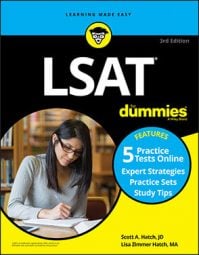The first few LSAT logic games you face can be a bit daunting, but remember, you can solve them by following the steps Try your skills on an in/out grouping game.
A building contractor creates a team of exactly six professionals to work on a construction site. He chooses from three plumbers: Harry, Ingrid, and James; three carpenters: Mary, Nick, and Oliver; and three tile installers: Andrew, Bert, and Ernestine. The contractor observes the following conditions in forming the team:
If Oliver is selected for the team, Andrew is not selected.
If James is selected for the team, Harry is not selected.
If James is selected for the team, Mary is also selected.
If Mary is selected for the team, Oliver is also selected.
The construction workers are either among the six who are in the group (+) or among the three who are out of the group (–). You know exactly six of the nine workers will be in and three will be out.
Start building your game board immediately. List the workers by letter underneath the headings of P, C, and T to keep track of each worker’s profession. Create a box chart with nine columns, six for the team members and three for those who are left out.
All rules provide if/then statements. The first tells you that if O is in, A is out. So it’s also true that if A is in, O is out, and O and A are never both in. Record these facts on your game board. The second rule is the same: If J is in, H is out, and if H is in, J is out.
The third rule is a little different. It tells you that if J is in, M is in. You also know the contrapositive — that if M is out, J is out. That’s the same as saying that you can’t have J without M.
The fourth rule is similar to the third. It states that if M is in, O is in. So you also know that if O is out, M is out. Record these rules on your game board.
Consider possible group assignments. Start with J because he’s a part of many rules. When J is in, M is in, and when M is in, O is in.
Add J, M, and O to the + side of the box chart. When J is in, H is out, so put H on the – side. O is in, so add A to the – side, too. The remaining three spots could be filled with either I, N, B or E.
When A is in, O is out, and when O is out, M is out. Add an option to your game board with A on the + side and O and M on the – side. One space remains on the – side.
That space has to be either J or H because they can’t both be in, and it has to be J because if you put J on the + side, you have to have M there too. So J is on the – side, and H, I, N, B, and E have to be on the + side of the chart.
The second option provides one possible assignment with H on the + side and J on the – side. With H on the + side, the – side could be J, A, and any one of I, N, B, E, or M. The four remaining pieces belong on the + side with O.
Which one of the following is an acceptable team of construction workers?
(A)Ingrid, James, Mary, Oliver, Bert, Ernestine
(B)Ingrid, James, Nick, Oliver, Bert, Ernestine
(C)Harry, James, Mary, Nick, Bert, Ernestine
(D)Harry, James, Mary, Oliver, Andrew, Bert
(E)Harry, Ingrid, Mary, Nick, Bert, Ernestine
The first question almost always asks for an acceptable assignment. Ignore your game board for now and answer this question by examining each of the four rules. The first rule says that if O is in, A is out. Choice (D) puts both O and A on the + side, so it’s wrong.
The second rule states that if J is in, H is out. Eliminate Choice (C) because it has both J and H on the + side. The third rule specifies that when J is in, M is in. Choice (B) has J with no M, so it’s incorrect. The fourth rule requires O to be in when M is in. Choice (E) has M with no O, so it’s out.
The correct answer that doesn’t violate a rule is Choice (A).
If Harry and Oliver are included on the team, then which one of the following must be true?
(A)Exactly two tile installers are on the team.
(B)All three carpenters are on the team.
(C)Mary is not a member of the team.
(D)James is a member of the team.
(E)Andrew is not a member of the team.
This add-a-rule question requires an answer that must be true. The temporary rule is that H and O are on the + side. The third line of the box chart gives you possible arrangements when H and O are on the team. Refer to that line to eliminate answers that either could be true or must be false.
Choice (A) could be true if the team included H, B, E, I, N, and O, but it isn’t true when the team assignment is H, B, M, I, N, and O. Choice (A) doesn’t have to be true, so it’s wrong. Likewise, M, N, and O could be on the team together but don’t have to be, so Choice (B) is out.
Mary either could or couldn’t be a member of the team, so Choice (C) is wrong. In no case can J be on the + side, so Choice (D) has to be false. The only answer that must be true is Choice (E).

